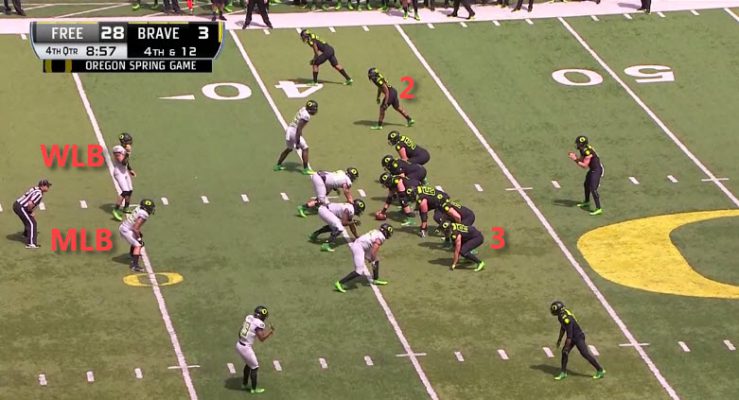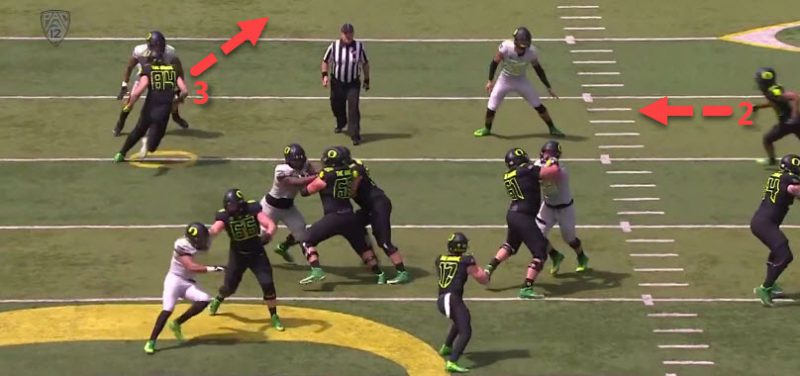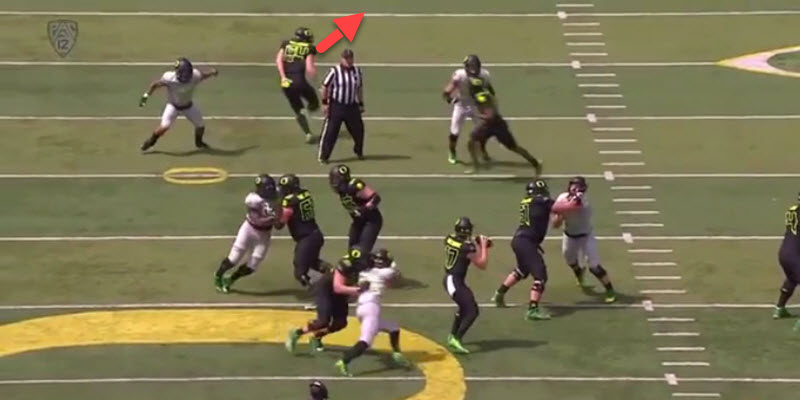This article by the Grizzled Ol’ Coach, Mike Morris, has been edited to conform to our protocol on the site. Words and punctuation have been added or changed to match other articles, hence not all of what you read below are precisely his words, but match his intent. Charles Fischer
The Oregon defense showed excellent improvement defending the run in the spring game, yet there were a number of areas for improvement in defending passes. The challenge comes from Oregon learning to play a man-to-man pass defense, but needs to implement “switching” between defenders as receivers pass through their area. It is not quickly learned, but can be very effective when mastered over this next season.
Let’s look at some mistakes or coachable moments where both the players and the fans can learn more about Oregon’s new “Switching Man-to-Man” pass defense.
The first example is an excellent look at why the linebackers (LBs) must aggressively “reroute” (knock the crap out of) crossing receivers.

The “pass key” numbering system for defenders.
In our first look at the alignment, (above) we see the Ducks’ middle linebacker, (Mike, MLB) No. 53 Blake Rugraff, who has the No. 2 receiver, the tight end (TE) as his “pass key”. We count receivers from the sideline inward, so the flanker is the No. 1, and the tight end is the No. 2 receiver. Defenders know which number they are supposed to cover based upon the defense called, thus they must recognize where “their’ receiver, or pass key is in the offensive formation.
An interesting side-note is how the offensive right tackle on the play above is deeper in his alignment than the TE in order to better pass block the Duck outside linebacker (DOLB.) Remember the “Duck” is a hybrid safety/outside linebacker in the new defensive system of defensive coordinator Jim Leavitt.
The Will, or weakside linebacker, (WLB) No. 39 Kaulana Apelu, (above) has the No. 2 receiver to his side, (the slot) in some coverages while the deep safety will account for the No. 2 in other pass defenses.

Not re-routing…
The tight end is going to “pick” or shield the WLB to free up the slot receiver., and the linebackers do nothing to prevent it. Both LBs should aggressively attack the inside shoulder of their pass keys, as they start to cross the field. Reroute ’em! Hit ’em! The best reroute technique is to knock the receiver on his ass, but the Ducks’ LBs appear to be playing a soft zone.
After aggressively rerouting, the LBs should “switch” the receivers they are covering in a “2-2 switch,” with the MLB taking the original No, 2 (the slot receiver) from one side and the WLB taking the original No. 2 (the TE) from the other. Rugraff is forced to cover the speedy freshman wide receiver No. 89, Darrian McNeal, crossing the field with a full head of steam. No way is that gonna happen.
If the LBs correctly rerouted their receivers, (above) the timing of the pattern would have been disrupted; McNeal would have been slowed down and had to restart his engine. The other defenders might have got a sack of the quarterback Justin Herbert? Nope, the DOLB (No. 19 Fotu Leiato) mistakenly loses contain of the QB on his pass rush.
We’ve showed a lot of Duck defensive highlights, and that definitely wasn’t one.

Looking at their pass keys…
In our next example, (looking at the alignment above) the MLB No. 55 A.J. Hotchkins, has the No. 3 receiver, the tight end, No. 84 Cam McCormick, as there is a Split End below the bottom of the screen. The WLB, No. 35, Troy Dye, has the No. 2 receiver, the slot.

Harder than it looks…
Here’s a great end zone view of the two inside LBs trying to execute a “2-3 switch” of pass receivers. There’s no “pick” of a defender on this pattern, as instead the offense tries to “lure” a positioning mistake from a linebacker.
Something to remember: There’s a “no cover zone” for the linebackers. They shouldn’t get closer than 5 yards (their alignment depth) to the line of scrimmage to cover a receiver until the ball is being thrown. If they get closer to the LOS, it can open an area for another receiver crossing behind them.
A.J. “almost” does a great job, as he gets good inside position on the TE and then he “kinda” reroutes him. (My only quibble with A.J. is–I think he should have hit the TE harder.) After releasing the tight end, (the No. 3 receiver) to his other linebacker, (Dye) A.J. does a wonderful job of switching and covering the crossing slot receiver. (Originally the No. 2 receiver) It’s a tough assignment; if A.J. stayed too long with the TE, the crossing slot would have been open.
Troy Dye also does part of his job correctly. He yells “In! In!” to his MLB, and then doesn’t enter the no cover zone to reroute the shallow crossing receiver. That receiver is the offense’s lure I mentioned.
Troy doesn’t take that bait, but then he didn’t switch and cover the TE, who then gets open. Troy was in position to make a beautiful pass defensive 2-3 receiver switch, but . . .

Learning our pass keys…
In the screenshot above, the WLB, No. 39 Kaulana Apelu, has the No. 2 receiver as his pass key. (The RB, Royce Freeman) The MLB, No. 53 Blake Rugraff, has No. 3 receiver as his pass key, the H-back. Our final video is an example of a player trying to do more than he should. Unfortunately it won’t be the last time that happens to the Oregon defense.

The MLB is doing it correctly…
The offense (above) fakes a sweep to Royce, and then Justin Herbert bootlegs back to the other side, in a passing action the Ducks used many successful times in the spring game.
When the MLB sees it’s a pass play, (above) he correctly checks his man (the H-back) to be sure he doesn’t run a delay pattern or screen, and then goes and helps elsewhere.
But when the WLB sees that his pass key (the RB) isn’t running with the ball, he sprints to the other side to help. Think he was right? You’re right – and Kaulana was wrong. The uncovered Royce Freeman gets a huge pass play gain on a wheel route, and all Apelu had to do was his job – cover his pass key, the No. 2 receiver to prevent it.
Well there are some “coachable moments” for you. I hope you and – much more importantly – the Oregon players learned from those moments.
Coach Mike Morris
Pleasant Hill, Oregon
Top Photo from Pac-12 Network Video
Coach Mike Morris spent 30 years coaching at seven different high schools throughout Southern California. He coached many players who went on to Pac-12 programs including Oregon, such as Saladin McCullough. He is a writer, Football analyst and a good friend of the Principal of the site.


